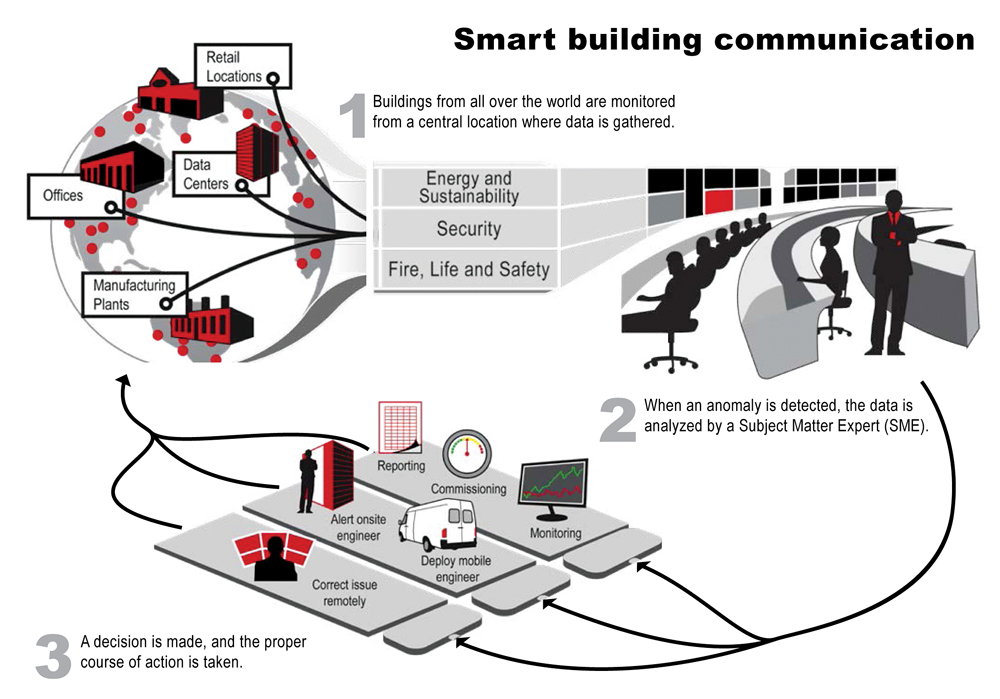Building automation systems and so-called “smart” controllers are nothing new. Building owners have been implementing remote monitoring and control systems for HVAC and lighting for decades. But with the cost of IT components like wireless sensors dropping and technologies like smart meters and cloud-based building management solutions coming on the market, a new era of connectivity and data generation is upon us.
The question becomes: How can commercial building owners leverage real-time, building-related data to more efficiently operate and maintain buildings? Can data analytics, for example, warn facilities teams about problems with equipment before they reach the point of failure? Can it detect subtle changes in fan speed, air temperatures, and energy consumption to trigger continuous adjustments to optimize equipment performance?
Real estate services giant Jones Lang LaSalle set out to answer these questions when it partnered with Pacific Controls to develop IntelliCommand, a 24/7 real-time remote monitoring and control service for its commercial real estate owner clients.
The service—which was pilot tested last year by Procter & Gamble on 12 of its buildings around the world, totaling 3.2 million sf—utilizes Pacific Controls’ wireless sensors to collect and send building performance data from various building automation systems to a remote command center operated by JLL. There, facilities operations experts who are well versed in data analytics and information technology are able to spot and diagnose anomalies that indicate a building system is not running efficiently.
The command center tracks data around the clock, allowing facilities experts to make constant adjustments to fine-tune building performance and address equipment problems before they become serious.
“We can do everything from test equipment to fix building controls remotely,” says Leo O’Loughlin, JLL’s Senior Vice President of Energy and Sustainability, who presented on the topic at BD+C’s BUILDINGChicago/Greening the Heartland conference in September. “For example, our command center has the ability to remotely test 500 VAV boxes in multiple buildings in multiple locations at 2 a.m. and then submit a work order for the 15 or 20 that need fixing.”
O’Loughlin calls JLL’s new service the future of commissioning—continuous, monitor-based commissioning versus the traditional approach of assess/diagnose/fix/let deteriorate. “It’s all about getting ahead of the maintenance curve,” he says.
The results from the P&G pilot test were impressive: energy costs were slashed by 10% across the 12 buildings in just 11 months, and the investment paid for itself in three months—all without implementing any major building system upgrades.
Managers were able to identify problems that manual inspections could not detect, according to O’Loughlin, including inaccurate thermostat default settings, a temperature anomaly indicating that a heater was operating when not needed, and room-to-room temperature differences that indicated malfunctioning dampers, triggering unnecessary air conditioning. The service saved 8% in energy costs at one pilot location simply by reducing HVAC activity on nights, weekends, and holidays.
“It makes smart buildings smarter,” says Larry Bridge, Global Facilities and Real Estate Governance Manager at P&G. Bridge is currently working with JLL to deploy IntelliCommand throughout its global real estate portfolio of 76 buildings. “Smart building technology is not just about energy cost savings,” he says. “We also get reliability improvements and more efficient work order production.”
Related Stories
| Dec 27, 2011
Suffolk Construction celebrates raising of Boston Tea Party Ships & Museum cupola
Topping off ceremony held on 238th Anniversary of Boston Tea Party.
| Dec 27, 2011
State of the data center 2011
Advances in technology, an increased reliance on the Internet and social media as well as an increased focus on energy management initiatives have had a significant impact on the data center world.
| Dec 27, 2011
USGBC’s Center for Green Schools releases Best of Green Schools 2011
Recipient schools and regions from across the nation - from K-12 to higher education - were recognized for a variety of sustainable, cost-cutting measures, including energy conservation, record numbers of LEED certified buildings and collaborative platforms and policies to green U.S. school infrastructure.
| Dec 21, 2011
DOE report details finance options for PV systems in schools
The report examines the two primary types of ownership models used to obtain PV installations for school administrators to use in selecting the best option for deploying solar technologies in their districts.
| Dec 21, 2011
AIA Chicago & AIA Chicago Foundation 2011 Dubin Family Young Architect Award announced
The Dubin Family Young Architect Award is bestowed annually and recognizes excellence in ability and exceptional contributions by a Chicago architect between the ages of 25 and 39.
| Dec 21, 2011
Few silver linings for construction in 2012
On the brighter side, nearly half of respondents (49.7%) said their firms were in at least “good” financial health, and four-fifths (80.2%) said their companies would at least hold steady in revenue in 2012.
| Dec 21, 2011
Hoboken Terminal restoration complete
Restoration of ferry slips, expanded service to benefit commuters.
| Dec 21, 2011
BBI key to Philly high-rise renovation
The 200,000 sf building was recently outfitted with a new HVAC system and a state-of-the-art window retrofitting system.
| Dec 20, 2011
Gluckman Mayner Architects releases design for Syracuse law building
The design reflects an organizational clarity and professional sophistication that anticipates the user experience of students, faculty, and visitors alike.
| Dec 20, 2011
Research identifies most expensive U.S. commercial real estate markets
New York City, Washington, D.C. and San Mateo, Calif., rank highest in rents.


















